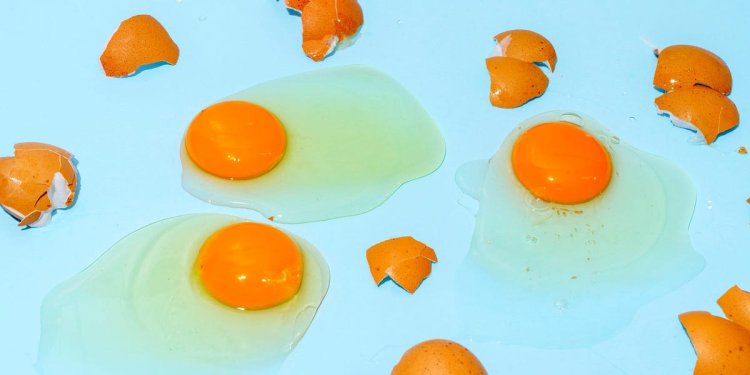It's not just you. Eggshells really are chipping more.
Have you noticed you're getting bits of shell in the bowl more often lately when you crack an egg? It's a real thing. Two experts told me why.

Javier Zayas Photography
- Have you noticed that eggs are getting more shell bits into the bowl or pan when you crack them?
- There's actually a reason — and it has to do with the same avian flu outbreak that made eggs so expensive last year.
- Older hens lay eggs with thinner shells, leading to more shell bits when you crack them.
Lately, I've noticed something strange in the kitchen.
Over the last few months, more and more often when I went to crack an egg, I'd get a piece of shell into the bowl or pan, forcing me to try to fish it out with my finger (one of the worst tasks in cooking —maybe even worse than doing dishes).
Even worse: A few times lately, I've had that dreaded bite where you chomp down on a piece of shell in your egg and cheese sandwich [shudder].
I've been cracking eggs the same way for decades with largely the same effect —until recently. Occasionally, I'd get some chips, but that's an exception, not the rule.
Now, it seems almost every egg I crack ends up with bits of shell in the bowl.
My technique hasn't changed. The type of eggs I buy hasn't changed. It's gotta be the eggs, right?
I asked around on social media. I felt like it was my pet conspiracy theory — that Big Egg was hiding a secret. But many others also thought they'd noticed the exact same phenomenon. Something has changed lately with eggshells.
I had to dig deeper.
Sheila Purdum is a professor of poultry nutrition at the University of Nebraska-Lincoln with a research focus on "nutritional factors affecting calcium utilization and shell quality in laying hens."
I asked Purdum about my theory about getting more egg chips in the bowl lately. "There is NO conspiracy theory, just biology affecting your eggs right now," she said.
Thinner shells are more likely to chip, and the nutrition of the chickens laying the eggs can have an effect on how thick or thin the shell is. But Purdum suspects it's something other than a change in chicken feed.
"I suspect the issue is due to the age of the National Flock," Purdum said over email. "Due to a large loss of flocks when affected by Avian Influenza, the remaining birds are kept in production longer, which then starts a cycle of poorer eggshell quality. "
Last year, egg prices went through the roof, with prices more than doubling in certain US states. Although inflation has affected grocery prices, the big reason for the egg price increase was a massive avian flu outbreak starting in 2022 that killed more than 58 million chickens and other birds.
Because so many chickens died from the flu, egg producers had to adapt. Normally, a commercial hen starts laying eggs around 5 months old and lays an egg per day until she's around 2 years old, at which point she's, uh, "retired" (let's just say there are no 401ks in factory farms).
But when half a producer's chickens die off early, they'll have to keep some of those older hens around longer. This means hens over 3 years old are in the mix.
Older chickens lay weaker eggs. "The producers increase calcium in the diet to help keep the eggshells strong," Purdum said. "But as in any animal, aging has detrimental effects causing osteoporosis and poor strength of both bones in the laying hen and subsequent eggshell strength."
Kevin Harvatine, professor of nutritional physiology in the Department of Animal Science at Penn State University, told me he recalls a similar thing happening — an older hen population — in 2015 after an avian flu outbreak decreased egg supply.
For now, I've switched up my technique to the recommended way of hitting it against a flat surface instead of the edge of the bowl or a fork. For hard-boiled eggs, adding a splash of white vinegar to the water while boiling can help ease peeling.
The good news is that egg prices have normalized, thankfully (although they're still more expensive than 2019).
That means the worst of the flu outbreak is over, and production is back up. And that likely means that the average ages of hens will return to normal, and shells will blissfully crack once more.
What's Your Reaction?




















